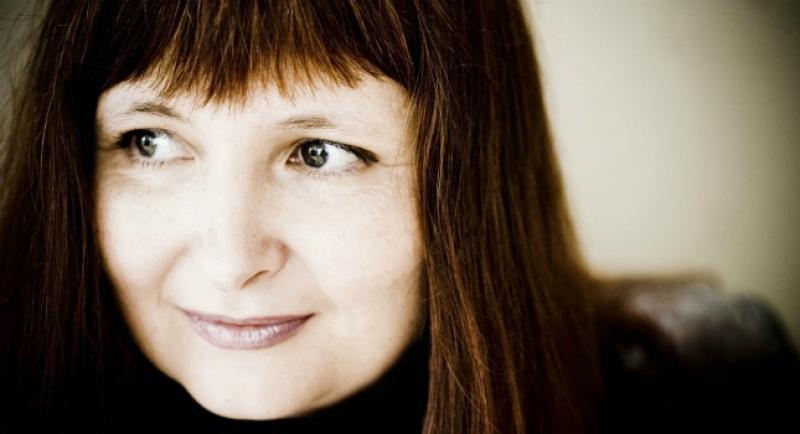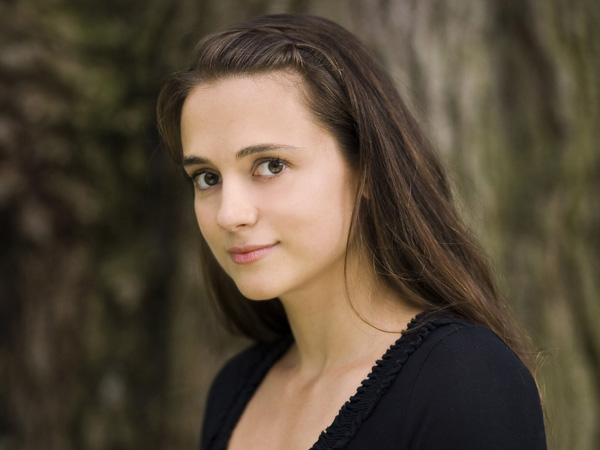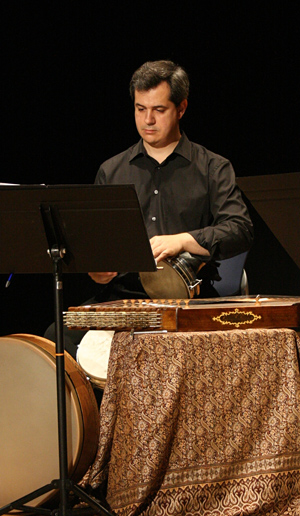L'Arpeggiata, Wigmore Hall | reviews, news & interviews
L'Arpeggiata, Wigmore Hall
L'Arpeggiata, Wigmore Hall
A little too much formality for a group at their best unbuttoned

Turning every concert into a party, baroque ensemble L’Arpeggiata are performers in the truest sense. Too often early musicians get away with being shy or downright awkward, visibly uncomfortable when forced to introduce an encore. Not so with these European virtuosi, whose signature improvisations give each member (yes, even the percussionist) the chance to step into a starring role. And don’t get me started on the baroque rap that concluded the group’s most recent London concert…
For the second of their three-concert residency at the Wigmore Hall, Christina Pluhar and L’Arpeggiata moved away from their usual themed musical programmes to focus on the music of Cavalli. It was an unusually straight programme from these mavericks, and one that threatened to corset their creativity in the tight limitations of a score.
It’s hard to imagine a better soprano in this repertoire than Núria Rial
Though structured with a fluidity that escapes even Monteverdi, bleeding from aria to arioso to instrumental dance, Cavalli’s operas still tend to linger on the same primary-coloured emotions. String ten or so arias back to back and you have a little too much intensity, lurching from despair to ecstasy and back again a little too frequently. It’s hard to imagine a better soprano in this repertoire than Núria Rial (pictured below), but even she couldn’t quite sustain the emotional pitch of it all.
 “Piangete, occhi dolente” from L’Egisto was deliciously and unremittingly chromatic, setting descending strings against a voice crawling ever upwards to chilling effect. Stranger by far however was “L’alma fiacca svani” from Didone, whose dying breaths gasped with a too-vivid musical death rattle. Rosinda’s “Vieni, vieni in questo seno” restored calm – a tender unfolding of melody that curved and arched in Rial’s delivery.
“Piangete, occhi dolente” from L’Egisto was deliciously and unremittingly chromatic, setting descending strings against a voice crawling ever upwards to chilling effect. Stranger by far however was “L’alma fiacca svani” from Didone, whose dying breaths gasped with a too-vivid musical death rattle. Rosinda’s “Vieni, vieni in questo seno” restored calm – a tender unfolding of melody that curved and arched in Rial’s delivery.
Pluhar’s taste is for natural singers, voices on the edge of the untrained simplicity of folk. Rial is a gift in this respect, balancing her beautifully rounded tones with a willingness to push expression beyond beauty or elegance. She and the ensemble had a blast in the vigorous musical satire of city life “Che città”, bemoaning encounters still familiar to every Tube-travelling Londoner, and also in Calisto’s exuberant “Non è maggior piacere”, in which she exalts in the delight of hunting.
 So much of this repertoire is dance-based, and Pluhar’s ensemble with its prominent rhythm section are adept at drawing this out. At times though, especially when the group broke into one of an instrumental Ciaccona or Canario, I just wanted them to stay in this exhilarating, conversational mode rather than return to the conventions and formalities of opera. These are all soloists, and from Margit Übellacker’s Psaltery to Doron Sherwin’s cornetto they can all hold an audience and deserved more opportunity to do so. Only David Mayoral (pictured left) and his athletic castanets really had the chance to take the spotlight.
So much of this repertoire is dance-based, and Pluhar’s ensemble with its prominent rhythm section are adept at drawing this out. At times though, especially when the group broke into one of an instrumental Ciaccona or Canario, I just wanted them to stay in this exhilarating, conversational mode rather than return to the conventions and formalities of opera. These are all soloists, and from Margit Übellacker’s Psaltery to Doron Sherwin’s cornetto they can all hold an audience and deserved more opportunity to do so. Only David Mayoral (pictured left) and his athletic castanets really had the chance to take the spotlight.
Cavalli is slowly (and surely, surely?) beginning to have something of a revival of fortunes. The Royal Opera’s La Calisto may now be some years back, but more recently English Touring Opera gave us a very fine Giasone, reminding us all just how good this is as music-drama – fluid in a way that later opera seria just isn’t. I hope that this programme, with its cherry-picked best bits, manages to speed the process. Stand-alone arias in the concert hall are one thing, no matter how well L’Arpeggiata stitch them into a continuous musical narrative, a fully staged opera would be quite another. There are 27 surviving to choose from, and, personally, I’m rooting for Didone.
- L'Arpeggiata return to the Wigmore Hall on 10 July 2014
rating
Explore topics
Share this article
The future of Arts Journalism
You can stop theartsdesk.com closing!
We urgently need financing to survive. Our fundraising drive has thus far raised £49,000 but we need to reach £100,000 or we will be forced to close. Please contribute here: https://gofund.me/c3f6033d
And if you can forward this information to anyone who might assist, we’d be grateful.

Subscribe to theartsdesk.com
Thank you for continuing to read our work on theartsdesk.com. For unlimited access to every article in its entirety, including our archive of more than 15,000 pieces, we're asking for £5 per month or £40 per year. We feel it's a very good deal, and hope you do too.
To take a subscription now simply click here.
And if you're looking for that extra gift for a friend or family member, why not treat them to a theartsdesk.com gift subscription?
more Classical music
 BBC Proms: Kholodenko, BBCNOW, Otaka review – exhilarating Lutosławski, underwhelming Rachmaninov
Polish composers to the fore in veteran conductor’s farewell
BBC Proms: Kholodenko, BBCNOW, Otaka review – exhilarating Lutosławski, underwhelming Rachmaninov
Polish composers to the fore in veteran conductor’s farewell
 theartsdesk at the Pärnu Music Festival 2025 - Arvo Pärt at 90 flanked by lightness and warmth
Paavo Järvi’s Estonian Festival Orchestra still casts its familiar spell
theartsdesk at the Pärnu Music Festival 2025 - Arvo Pärt at 90 flanked by lightness and warmth
Paavo Järvi’s Estonian Festival Orchestra still casts its familiar spell
 BBC Proms: Batsashvili, BBC Scottish Symphony Orchestra, Ryan Wigglesworth review - grief and glory
Subdued Mozart yields to blazing Bruckner
BBC Proms: Batsashvili, BBC Scottish Symphony Orchestra, Ryan Wigglesworth review - grief and glory
Subdued Mozart yields to blazing Bruckner
 Classical CDs: Hens, Hamburg and handmaids
An unsung French conductor boxed up, plus Argentinian string quartets and baroque keyboard music
Classical CDs: Hens, Hamburg and handmaids
An unsung French conductor boxed up, plus Argentinian string quartets and baroque keyboard music
 BBC Proms: McCarthy, Bournemouth SO, Wigglesworth review - spring-heeled variety
A Ravel concerto and a Walton symphony with depth but huge entertainment value
BBC Proms: McCarthy, Bournemouth SO, Wigglesworth review - spring-heeled variety
A Ravel concerto and a Walton symphony with depth but huge entertainment value
 BBC Proms: First Night, Batiashvili, BBCSO, Oramo review - glorious Vaughan Williams
Spirited festival opener is crowned with little-heard choral epic
BBC Proms: First Night, Batiashvili, BBCSO, Oramo review - glorious Vaughan Williams
Spirited festival opener is crowned with little-heard choral epic
 Interview: Quinteto Astor Piazzolla on playing in London and why Mick Jagger's a fan
Music Director Julián Vat and pianist Matias Feigin compare notes on Piazzolla
Interview: Quinteto Astor Piazzolla on playing in London and why Mick Jagger's a fan
Music Director Julián Vat and pianist Matias Feigin compare notes on Piazzolla
 Classical CDs: Bells, birdsong and braggadocio
British contemporary music, percussive piano concertos and a talented baritone sings Mozart
Classical CDs: Bells, birdsong and braggadocio
British contemporary music, percussive piano concertos and a talented baritone sings Mozart
 Siglo de Oro, Wigmore Hall review - electronic Lamentations and Trojan tragedy
Committed and intense performance of a newly-commissioned oratorio
Siglo de Oro, Wigmore Hall review - electronic Lamentations and Trojan tragedy
Committed and intense performance of a newly-commissioned oratorio
 Alfred Brendel 1931-2025 - a personal tribute
A master of feeling and intellect
Alfred Brendel 1931-2025 - a personal tribute
A master of feeling and intellect
 Aldeburgh Festival, Weekend 2 review - nine premieres, three young ensembles - and Allan Clayton
A solstice sunrise swim crowned the best of times at this phoenix of a festival
Aldeburgh Festival, Weekend 2 review - nine premieres, three young ensembles - and Allan Clayton
A solstice sunrise swim crowned the best of times at this phoenix of a festival

Add comment